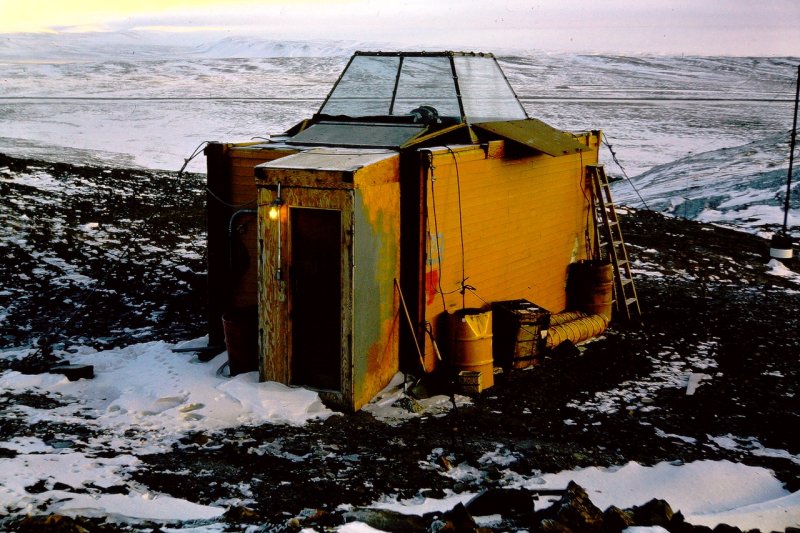
Contributed by John Matthews

Ed Note: I don't recall this shack being in place when I was at Thule J-Site in 1961-62. It was apparently added to help increase the tracker's accuracy. - Gene
Despite it's humble appearance from outside, this little building held some pretty hi-tech stuff! First of all, was its location - approximately 200 yards down the road from the tunnel entrance to J-site. The location was important because the building had to be BELOW the lip of the road where it flattened out for the entrance to J-site. It needed to be be below the crest of the road, so any lights from J-site were obscured by the terrain - in other words, no light pollution for this building. Second, it had electricity, so a special cable was installed from J-site down to the building. And, as you can see, the building had an unusual glass structure on the roof. Inside the building was a large Tektronix oscilloscope, a very good military communications receiver - tuned to WWV to obtain very accurate time, a specially modified tape recorder, and - most unusual - a high powered two man Theodolite.
The structure inside the building was also unusual. Like most of Thule's buildings, this building had a raised floor - about three feet - to prevent people standing on the floor from transmitting heat down to thaw the permafrost which, among other things, supported the isolated structure on which the Theodolite was mounted.
The Theodolite was unusual, in that it required two people to operate it. Each person - one each, on opposite sides of the optical telescope - had a hand wheel to move the (Theodolite) telescope in either azimuth or in elevation. So the Theodolite was really just an excellent telescope with each operator having a clear view of the Thule night sky, but requiring both operators - one cranking “elevation" and the other cranking “azimuth" to follow a “target". The Theodolite also had one other feature. When an operator pressed a button on the end of a cable, the Theodolite would print out on a paper tape, it's current azimuth and elevation setting - so you got a permanent record of each azimuth and elevation data points during a “target” track.
The military communications receiver provided the accurate time and the modified tape recorder tied the whole thing together, because the Theodolite (impact) printer produced a characteristic sound whenever its printer button was pressed.
So now you have three critical orbital parameters, azimuth, elevation, and time. If you get a series of these data sets - azimuth, elevation, and time - in an ideal world - you can calculate an orbit for - say, a Russian satellite.
I don't really know how accurate the Tracking Radar was when it was first went on line, but I do think that after a series of "simo-tracks" - tracking the same earth orbiting space object with the Tracker and the Theodolite - I think the Tracking Radar dramatically improved its accuracy.
I also know that, using a program developed by programmers assigned to MIP, the Theodolite first tracked a series of bright stars - so the ability of the Theodolite to track space objects - stars or satellites was about as good as it's possible to get!
So there you have it. I think this simple building and system - designed by a couple of very sharp minds in Systems Integration Group - was responsible for a dramatic improvement in the Tracking Radar's accuracy!